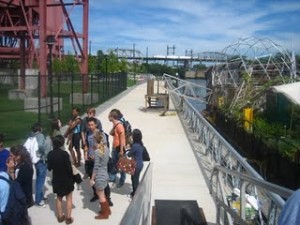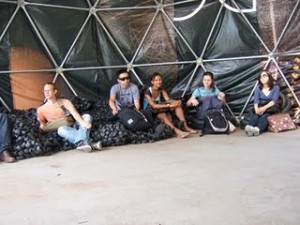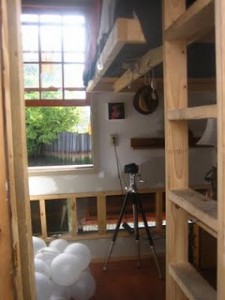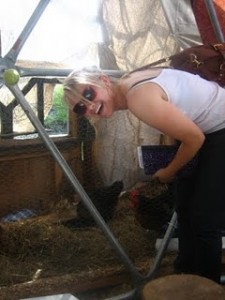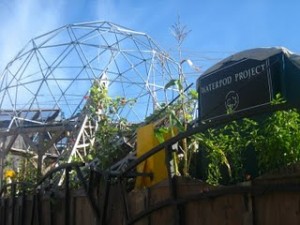 Mary Wood’s class ‘What Would Gordon Matta-Clark Do?’ took our first trip up to the Bronx. We had to arrive at Hunt’s Point so early that I overestimated the travel time, somewhat purposefully, but got there with 40 minutes to kill. Luckily I was not alone. Danielle, Dakota and I leisurely strolled down South Ave. in search of a cup of ice coffee. Coffee in hand, we made our way back to the meeting place, and there was Mary Woods excited to get started. She gave a brief overview of the history of The Bronx, and since most of us had never visited that borough, we were glad for some key informative points and orientation tools. Then the group was herded to the Concrete Plant Park, where artist Mary Mattingly’s “Waterpod” project was docked.
Mary Wood’s class ‘What Would Gordon Matta-Clark Do?’ took our first trip up to the Bronx. We had to arrive at Hunt’s Point so early that I overestimated the travel time, somewhat purposefully, but got there with 40 minutes to kill. Luckily I was not alone. Danielle, Dakota and I leisurely strolled down South Ave. in search of a cup of ice coffee. Coffee in hand, we made our way back to the meeting place, and there was Mary Woods excited to get started. She gave a brief overview of the history of The Bronx, and since most of us had never visited that borough, we were glad for some key informative points and orientation tools. Then the group was herded to the Concrete Plant Park, where artist Mary Mattingly’s “Waterpod” project was docked. 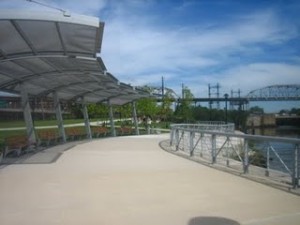
We approached the Waterpod and were greeted by Mary Mattingly and her crew. She told us about her visions of the Waterpod and what she hoped to achieve with this project. It’s a small artist community that is living self-sufficiently on a barge that floats around the city and has docked at all five boroughs. There was an immense amount of paperwork and red tape that Mary had to go through to make this idea a reality. She said the whole process was quite a learning experience.
After all the i’s were dotted and t’s were crossed, Mary and her fellow artists participating in the design of the Waterpod components had three weeks to build the Waterpod on the barge out in the Brooklyn Navy Yard. The materials were almost all found locally—metal from Broadway productions, wood planks from old water towers, and even soap opera backdrops for their bedroom walls.
Generally Mary’s work has dealt with the notion of a distopic future, which preferences the autonomous being and a self-sustaining nature. The Waterpod was Mary’s realization that there needs to be a more interactive way of self-sufficiency and group autonomy, differentiating between a hermetic lifestyle and a connected one.
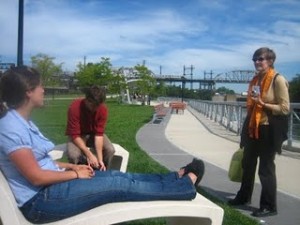 After Mary shared such information about her views on art and sustainability, in particular her most recent Waterpod piece, the class was split in two and the first half made their way onto the Waterpod. I was in the half that was left on dry land with Mary Woods for the first half, so we wandered through the Concrete Plant Park. Clearly the park had been recently revamped, giving the area a clean, green, and inviting feel. We took advantage of all the provided seating, as it was not only aesthetically interesting in the context of the whole park, but quite comfortable and fun to occupy.
After Mary shared such information about her views on art and sustainability, in particular her most recent Waterpod piece, the class was split in two and the first half made their way onto the Waterpod. I was in the half that was left on dry land with Mary Woods for the first half, so we wandered through the Concrete Plant Park. Clearly the park had been recently revamped, giving the area a clean, green, and inviting feel. We took advantage of all the provided seating, as it was not only aesthetically interesting in the context of the whole park, but quite comfortable and fun to occupy.
When it was our time to tour the Waterpod, we hopped onto the docked barge and found even more seating! This time in the form of cut black foam shapes. They were so comfortable that the surrounding geodesic dome seemed to melt away. The dome is used as their public space or living room. Other areas of the barge had a kitchen area and shower that used purified rainwater flowing through a faucet by gravity. There were four small but surprisingly functional bedrooms where Mary and her crew of artists were to sleep for the five months of their Waterpod experience.

